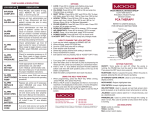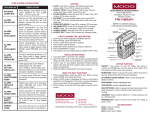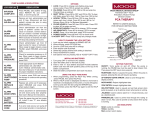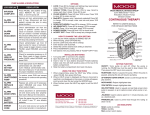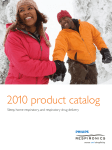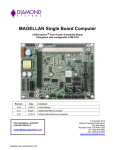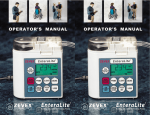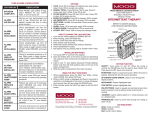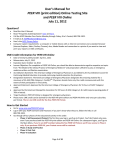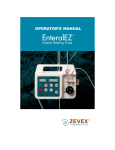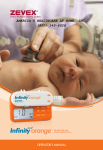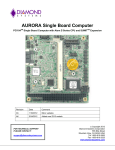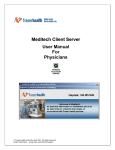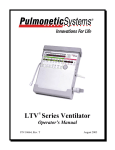Transcript
Technoelectric Dependent Children Kazumi Sakashita, MD, Loren Yamamoto, MD, MPH, MBA, FAAP, FACEP, Wallace Matthews, MD, FAAP Pediatrics, University of Hawai‘i John A. Burns School of Medicine and Kapi‘olani Medical Center for Women & Children, Honolulu, HI Background Children with special health care needs (CSHCN) are medically complex and often dependent on electrical technology devices (technoelectric dependent) for life support or maintenance. If they cannot utilize these devices, it would jeopardize their lives. Natural disasters are not the only reason for electricity failure. There are various causes of electricity outage (Table 1) and it is a common “disaster” that we experience in our daily lives. Though technoelectric dependent CSHCN sometimes plan to utilize electricity at the hospital in such events, this is unreliable rendering them vulnerable, because of traffic gridlock and hospital lockdown during a massive blackout or disaster. The purpose of this study is to survey CHSCN for electrical power failure vulnerability in the event of electrical power failure. 1. Attribute to electric power company Unexpected cause • Excessive demand for electric power • Natural disaster: earthquakes, lightning, fire, wind, snow, flooding, tsunami • Man-made outages: vehicle and construction accidents with power poles and power lines, maintenance from utilities, and the occasional human error. • Breakdown of power plant or power distribution station • Animals coming into contact with power lines (e.g. birds) • Elective or rolling blackout: construction, effort to avoid massive blackout due to excessive demand. • Fuel deficiency: secondary to economy, weather, political reason Expected cause Q3-4.Device and the availability of back-up battery Number of children 10 20 30 40 Q8. How long ago was the last time that battery back-up was checked or used to confirm the battery works? 50 1 Everyday (22%) 14% Feeding pump 22% Pulse oximeter Suction 2% Age range 5 months to 25 years. Male 29 (58%), female 21 (42%). 94% of families felt that their children need an electrical medical device to maintain their lives. We found many of devices did not have back-up batteries. 86% feel their most important device will not run more than 1 day without electricity. Half did not have any back-up plan. Three fourths did not have a generator. Though almost 90% possessed automobiles, half of them were not aware that a car can generate electricity. Our research revealed that most families are not prepared enough for electrical power failure. 2. Does your child have any electrical medical devices that are required to maintain his/her life? 3. Which device your child requires: Feeding pump, Drug infusion pump, Oxygen concentrator, Ventilator, Other lung support device, Asthma nebulizer, Pulse oximeter, cardiorespiratory monitor (CRM),Other 4. For each device that your child has, does it have a battery back-up? 5. Which device is most important to maintain your child’ s life? 6. How many hours per day, does your child normally use this device? 7. How many hours can this device continue to run continuously if a power failure occurs, relying on battery power alone? 8. How long ago was the last time that battery back-up was checked or used to confirm that the battery works? Not 7 applicable (No back-up battery) (14%) Q9. How long can your child survive if this device fails? 10. If Hawaiian Electric has a prolonged power failure (more than a day), do you have a back up plan on how to supply electrical power to this device? 11. Do you have an electrical generator? 12. Has the generator ever been tested? 13. This generator works with gasoline light? 14. Do you know what kind of oil (not gasoline) your generator requires? 15. Do you have the oil that is needed? humidifier Back-up battery Available Series1 Cough assist Peritoneal dialysis 1-5 days 28% Q5. Which device is most important to maintain your child’s life? Q6. How many hours per day, does your child normally use this device? Number of children 0 5 10 15 Feeding pump 20 2 Suction Pulse oximeter 24 Humidifier 24 Cough assist 2 Peritoneal dialysis No or Don’t know 74% Yes 26% Q7. How many hours can this device to run continuously if power failure, relying on battery power alone? >5 days 2% Q16. Do you have access to a car or van? No 52% Yes 48% Yes 86% Q17. Are you aware that a car/van can be used to generate electricity? Q18. Do you have a device that converts your car’s electricity to household electricity (an inverter)? >5hr,<1d 26% No 14% Don't know 4% 1-5 days 8% 1-5 hrs 18% No or Don’t know Yes 26% 74 % 1 hr or less 42% No or Don’t know 82 % Yes 18% Strength Weakness Home standby generator $2000 3000 2000-5000 watts •It can be used as 24/7 automatic power protection. Runs on existing natural gas or LP fuel. •Need experts to install. •Expensive. •Need natural gas or LP fuel. Portable power generator <$1000 1000-3000 watts •Portable and compact. •Less expensive. •Purchasable in most of places. •Requires frequent refueling. •Carbon monoxide production •Need to store gasoline appropriately. •Oil (lubricant) is also required. Table 3. Examples of devices which theoretically can be operated by cigarette lighter plug inverter Yes 44% Has the generator ever been tested? Yes 92% No 8% Does the generator work with gasoline right? Yes 77% No or Don’t know 13% Do you know what kind of oil your generator requires? Yes 69% No 31% Do you have the oil that is needed? Yes 46% No or Don’t know 54% 10 :Number of average hours of use per day No or Don’t know 56% Q11-15. Do you have an electrical generator? 1 O2 concentrator >5hr,<1day 16% Q10. Do you have a back-up plan? 17 Asthma nebulizer 1-5 hrs 6% 20 12 Ventilator 17. Are you aware that car/van can be used to generate electricity? 19. Has anyone ever tested this to see if this can power your child’s life support device? >5 days 34% Back-up battery NOT available Series2 Electric wheel chair 16. Do you have access to a car or van? 18. Do you have a device that converts your car’s electricity to household electricity that can be used to power devices that normally plug into household outlet? 1 hr or less 14% Don't know 2% Chest vest The capacity 3. Car power inverter This is the simplest, safest and most economical way to generate electricity. Car generates 12 VDC with approximate max current flow 20A. “Inverter” can supply AC power from any 12V battery or automotive DC source simply by by plugging jinto the cigarette lighter. Most inverters can continuously supply 100-200 watts of 110-120V AC power to one or more AC outlets. The prices range From $10 to $50, varying depending on the maximum surge capacity. When we use a cigarette lighter, the power ratings of the 12-V inverters are limited up to 20A by the electrical current capacity of its wire, which means we can get up to 240 watts (20A x 12VDC). If we need more electricity, we can use bigger inverter with heavy-duty cable clamps connected directly to the battery . Some products allow us to generate 2000 watts or more. This method requires more technical expertise and is more risky, because there is the possibility of a battery short circuit, which could melt wires, damage the life support device, or cause a fire. Car’s engine should be running to prevent the battery depletion, in non-enclosed area to avoid carbon monoxide intoxication. Thus, theoretically, we can run any medical devices which works on 240 watts or less by using cigarette lighter plug. Considering some devices require higher surge power to be started, as well as the speed of power consumption depends on the power demand, we must test in a drill to determine if each device will actually work. Never been checked (42%) 6 Ventilator 9. How long can you child survive if this devices fails? 3 weeks ago (0%) 1-3 1-2 4 months ago (10%) >52months ago (10%) Oxygen concentrator Table 2. Questionnaire 1. Enter your child age and gender. 0% 10% CRM Results 10% 42% Cost 2 Once a week or more (2%) Asthma nebulizer Physicians caring for CSHCN who live at home were asked to complete a technoelectric dependency and preparedness questionnaire (Table 2) via phone or personal interview. We excluded CSHCN who are in long-term nursing facilities. We collected data from 50 patients who daily depend on a medical electric device at home. Our research revealed most of CSHCN are unprepared for power failure. We have several suggestions: 1. Having a back-up battery kit. For devices with rechargeable battery, back-up battery should be available. Battery itself usually does not cost much and is purchasable from each company. It needs to be charged in regular base, otherwise power will be discharged. Family needs to be aware how many hours it can be used when used alone. 2. Generator . In the US, electricity is provided at 110 or 120 volts, 60Hz. As a basic rule, watts (a unit of power) = Volts x Ampere. Generators are useful, but they can be difficult to manage appropriately. Type • Breakdown of circuit breaker: due to water, dust, age, weather • Accidental unplugging. 2. Attribute to each facility or house 0 Methods Discussion Table 1 . The causes of electricity outage Q19. Has anyone ever tested this to see of this can power your child’s life support device? Device EnteraLite Infinity (ZEVEX) Electrical Requirement Lithium Ion Battery. Input 5VDC 2.4A. Life: 24 hours @ 125 ml/hr KANGAROO JOEY Feeding Pump (KENDALL) LTV® Series Ventilator (Pulmonetic Systems, Inc.) Operate on A/C power or battery power. Operates on 5V DC, 2.4 A. Life: ≥ 18 hrs at 125 mL/hr DeVilbiss® Suction Unit EverGo™ Portable Oxygen Concentrator (RESPIRONICS) Operate on 90-250 VAC, 47-63 Hz or battery power (Battery Run Time 60mins) Nominal Power Draw: Startup 66 watts. Running 36 - 48 watts Operate on 100-240 VAC, 50/60Hz, 0.75A, or battery power (Battery Run Time 60mins). Power Consumption 33 Watts Max. Operate on - Lithium ion batteries 14.4 VDC (nominal) -AC power 100 to 240 VAC, 50/60 Hz, 1 A. Power Consumption: 110 W @ 100 VAC while charging. 70 W while not charging -DC power 12-18VDC, 5.0A max (DC power code included in the kit 4. Pediatricians’ role Hospitalists often encounter CSHCN in inpatient settings, which is a great opportunity to convey to caregivers the importance of preparing for power failure. In addition to a general emergency plan as AAP recommends, concrete plans to keep essential medical devices running during power failures should be a part of discharge instruction and disaster planning. Hospitalists often have some advantage (more face to face time) over PCPs who have limited visit times. Hospital care is where most CSHCN receive their medical care when they are more seriously ill, which puts caretakers in a more serious mood to review disaster preparation measures. Moreover, we all should acknowledge the emergency plan of each area provided by local government, such as the Emergency Alert system of each state, the places to evacuate, the locations of emergency shelters, and the information sources. Prompt on-site supports are crucial to help CSHCN. We need to be ones who can provide necessary information and care. Conclusions Electricity is largely taken for granted, but there are many situations when it can be difficult to obtain reliable power. Most CSHCN who are vulnerable to power failure are found to be unprepared. They should routinely drill for electricity power failure. We pediatricians play an important role to address this aspect of disaster preparedness. Reference: AAP, Committee on Pediatric Emergency Medicine, Council on Clinical Information Technology, American College of Emergency Physicians and Pediatric Emergency Medicine Committee: Policy Statement---Emergency Information Forms and Emergency Preparedness for Children With Special Health Care Needs. Pediatrics Vol.125, No. 4 April 2010;125;829-837. www.pediatrics.org/cgi/doi/10.1542/peds.2010-0186 AAP, Committee on Pediatric Emergency Medicine Committee on Medical Liability and the Task Force on Terrorism: Policy Statement---The Pediatrician and Disaster Preparedness. Pediatrics Vol. 117 No. 2 February 2006, pp. 560-565 (doi:10.1542/peds.2005-2751) AAP: Overview Booklet FAMILY readiness kit : preparing to handle disaster. http://www.aap.org/family/frk/aapfrk1.pdf User Manual of EnteraLite Infinity (ZEVEX), KANGAROO JOEY Feeding Pump (KENDALL), LTV® Series Ventilator (Pulmonetic Systems, Inc.) DeVilbiss® Suction Unit, EverGo™ Portable Oxygen Concentrator (RESPIRONICS) State of Hawaii Emergency Alert System Plan. http://www.scd.hawaii.gov/documents/EAS_Plan.pdf
